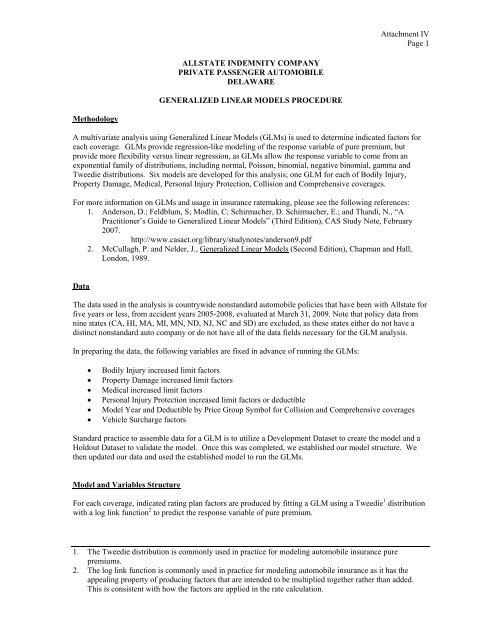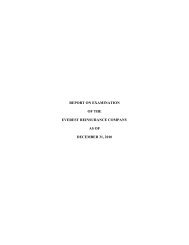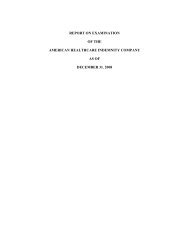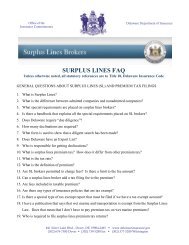Filing at a Glance General Information - Delaware Insurance ...
Filing at a Glance General Information - Delaware Insurance ...
Filing at a Glance General Information - Delaware Insurance ...
You also want an ePaper? Increase the reach of your titles
YUMPU automatically turns print PDFs into web optimized ePapers that Google loves.
Methodology<br />
ALLSTATE INDEMNITY COMPANY<br />
PRIVATE PASSENGER AUTOMOBILE<br />
DELAWARE<br />
GENERALIZED LINEAR MODELS PROCEDURE<br />
Attachment IV<br />
Page 1<br />
A multivari<strong>at</strong>e analysis using <strong>General</strong>ized Linear Models (GLMs) is used to determine indic<strong>at</strong>ed factors for<br />
each coverage. GLMs provide regression-like modeling of the response variable of pure premium, but<br />
provide more flexibility versus linear regression, as GLMs allow the response variable to come from an<br />
exponential family of distributions, including normal, Poisson, binomial, neg<strong>at</strong>ive binomial, gamma and<br />
Tweedie distributions. Six models are developed for this analysis; one GLM for each of Bodily Injury,<br />
Property Damage, Medical, Personal Injury Protection, Collision and Comprehensive coverages.<br />
For more inform<strong>at</strong>ion on GLMs and usage in insurance r<strong>at</strong>emaking, please see the following references:<br />
1. Anderson, D.; Feldblum, S; Modlin, C; Schirmacher, D. Schirmacher, E.; and Thandi, N., “A<br />
Practitioner’s Guide to <strong>General</strong>ized Linear Models” (Third Edition), CAS Study Note, February<br />
2007.<br />
http://www.casact.org/library/studynotes/anderson9.pdf<br />
2. McCullagh, P. and Nelder, J., <strong>General</strong>ized Linear Models (Second Edition), Chapman and Hall,<br />
London, 1989.<br />
D<strong>at</strong>a<br />
The d<strong>at</strong>a used in the analysis is countrywide nonstandard automobile policies th<strong>at</strong> have been with Allst<strong>at</strong>e for<br />
five years or less, from accident years 2005-2008, evalu<strong>at</strong>ed <strong>at</strong> March 31, 2009. Note th<strong>at</strong> policy d<strong>at</strong>a from<br />
nine st<strong>at</strong>es (CA, HI, MA, MI, MN, ND, NJ, NC and SD) are excluded, as these st<strong>at</strong>es either do not have a<br />
distinct nonstandard auto company or do not have all of the d<strong>at</strong>a fields necessary for the GLM analysis.<br />
In preparing the d<strong>at</strong>a, the following variables are fixed in advance of running the GLMs:<br />
Bodily Injury increased limit factors<br />
Property Damage increased limit factors<br />
Medical increased limit factors<br />
Personal Injury Protection increased limit factors or deductible<br />
Model Year and Deductible by Price Group Symbol for Collision and Comprehensive coverages<br />
Vehicle Surcharge factors<br />
Standard practice to assemble d<strong>at</strong>a for a GLM is to utilize a Development D<strong>at</strong>aset to cre<strong>at</strong>e the model and a<br />
Holdout D<strong>at</strong>aset to valid<strong>at</strong>e the model. Once this was completed, we established our model structure. We<br />
then upd<strong>at</strong>ed our d<strong>at</strong>a and used the established model to run the GLMs.<br />
Model and Variables Structure<br />
For each coverage, indic<strong>at</strong>ed r<strong>at</strong>ing plan factors are produced by fitting a GLM using a Tweedie 1 distribution<br />
with a log link function 2 to predict the response variable of pure premium.<br />
1. The Tweedie distribution is commonly used in practice for modeling automobile insurance pure<br />
premiums.<br />
2. The log link function is commonly used in practice for modeling automobile insurance as it has the<br />
appealing property of producing factors th<strong>at</strong> are intended to be multiplied together r<strong>at</strong>her than added.<br />
This is consistent with how the factors are applied in the r<strong>at</strong>e calcul<strong>at</strong>ion.






